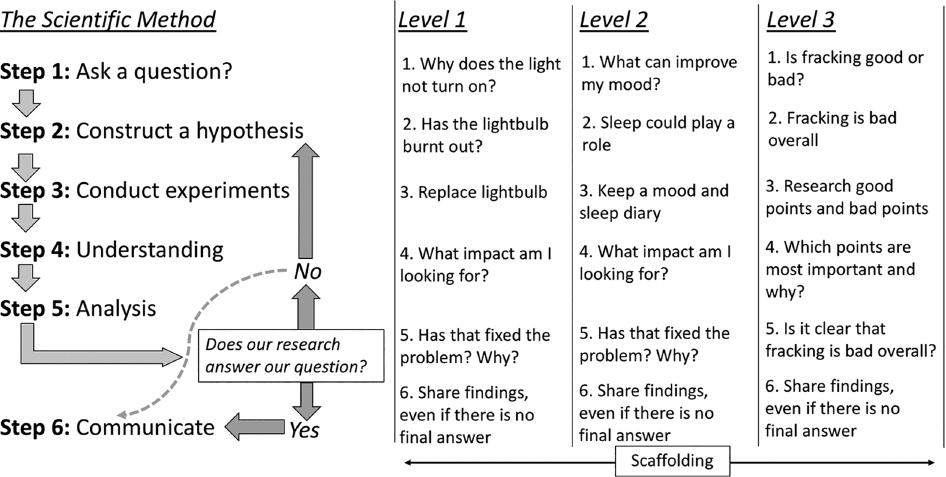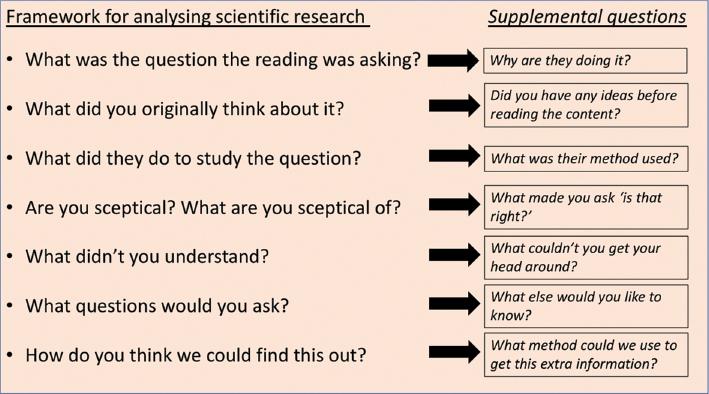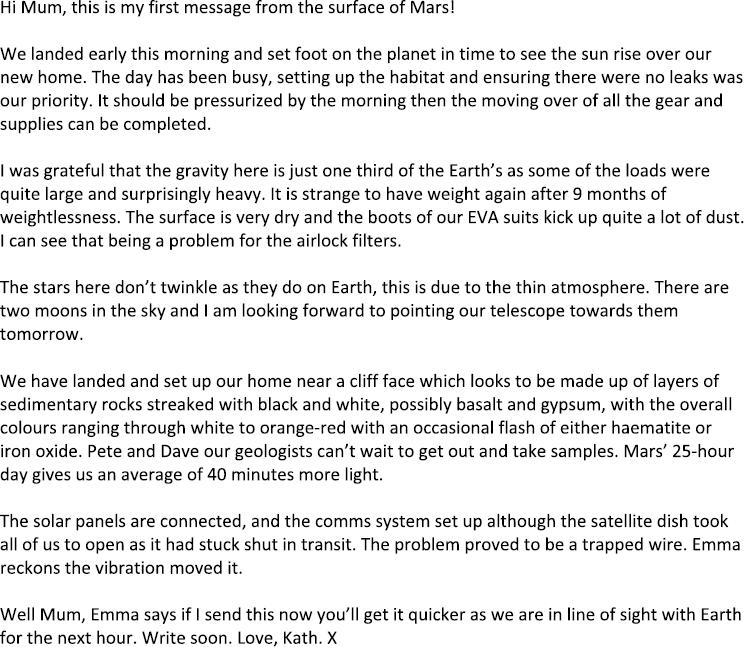Background
The science outreach course, Think Like a Scientist (Heron and Williams, 2022), taught in prisons in England, focuses on the scientific method (Figure 1), and the three pillars of being a scientist: understanding, analysis and communication. At the beginning of the course, the scientific method is presented as a way of thinking for tackling educational endeavours and navigating personal challenges, providing the bedrock for the learning approach of the course. It is emphasised that the majority of science experiments (and scientific thinking) end in ‘failure’ – scientists mostly do not come to an answer immediately, and working on theories takes time.

Examples of the scientific method used as a guide for exploration. The scaffolding technique is presented to show how the same framework can be applied to a number of different scenarios (for example, Levels 1, 2 and 3) (Source: adapted from Heron and Williams, 2022)
The course explores a different topic each session (for example, climate change and space exploration), with the scientific information presented in the style of a podcast or a TED talk: 15-minute segments of science built around a narrative. These short bursts of information form the students’ understanding of a subject. The students are then taught how to analyse by dissecting public-facing articles written by scientists. Examples of such material are found in The Conversation (https://theconversation.com/uk) – an online magazine that is pitched as an independent source of news and views, sourced from the academic and research community, and delivered direct to the public.
A key part of Think Like a Scientist is recognising that learning is a lifelong process, and that acknowledging when we do not understand something is considered a hallmark of a scientist. With this in mind, students are guided by questions about how to communicate the findings and their own interpretations of their readings (Figure 2), including ‘What do I not understand?’, ‘What are the authors missing?’ and ‘What else would you like to know?’ By promoting their own voice and opinions, the students begin to find their feet and start thinking like a scientist (Davenport Huyer et al., 2020).

Examples of questions used to guide the analysis of a subject or reading. Note the question ‘What didn’t you understand?’, indicating that ‘failure’ is part of the process of understanding
The course is designed to be accessible, inclusive and relatable to students. Specifically, the course is always held in ‘neutral’ venues with no historic link to formal prison education (such as a library) to create an accessible environment (see Heron and Williams, 2022). The language used in the course is inclusive, taking into consideration cultural and neurodivergent needs (see, for example, Mazur, 2000). Furthermore, the material is presented by relating scientific material to the world around the students, to allow for a more direct connection to content (see, for example, Cents-Boonstra et al., 2021).
In this article, those involved in preparing or teaching the Think Like a Scientist outreach programme invited two former students to share their experiences of the course and the wider prison education set-up. As detailed student descriptions in this field are limited in the literature, this case study provides written student statements to bridge a potential knowledge gap about student perspectives upon prison education.
Student reflections
This section includes reflections from two former students on the impact of learning science in prison, as written in their own words in response to prompted questions (with some minor edits to contextualise the situation for the reader).
Student 1: Dalton
Why did you join the course?
When you enter prison, you become a ghost: you are no longer visible to society and you are taken into another world. For some, circumstances have brought them to prison, and they try to better themselves through education. However, when I first got asked if I wanted to participate in a project run by an academic about science, I laughed. My mind fell down a memory rabbit hole of detentions and poor grades. I had been told my whole life I was useless, and now I was here, in prison, as if I had lived up to a self-fulfilling prophecy. One thing that prison does is give you time to think. I looked at what Think Like a Scientist was doing, and I realised this was what I never knew I needed.
What did you learn from the course?
On the first day, there was confusion as I entered the class. The instructor said, ‘I tried to set the room up, but the light won’t come on.’ I looked at the man that appeared next to us, while we stood silently waiting to be told what happens next. Someone behind me spoke: ‘Is there a switch, sir?’ Another said: ‘Is the door unlocked?’ ‘This is a new room, and I think the lights are on a sensor.’ I followed him in. ‘I tried that, but, no, it’s still not working’, he replied.
I walked ahead to the centre of the room. ‘Sometimes you have to walk further in, as the sensor won’t pick you up, if it’s a motion sensor.’ I waved my arms about. We all sat down; the instructor smiled, and said ‘Congratulations, you are all scientists.’
My whole life seemed to rush at me at once. I let out the air in my chest, I felt I had been holding in for too long. The instructor explained that we had all done what every scientist does: gather information, formulate a hypothesis and use critical thinking to solve the problems [Figure 1]. As we discussed this further, he told us that no mistake is a wrong answer, but a closer step to the conclusion. Scientists use other academic theories, and build on them to expand knowledge and understanding. Even if one person spends time on a theory that does not work, it can be used with other theories to try and progress. I went from thinking about my own past and connecting the present with previous traumas and behaviours, to thinking why I ever thought those things in the first place.
When we began learning about the universe, my mind felt like it had expanded beyond gates and fences. In that room, I felt connected to the world. I was not trapped, but free to see everything as it was. In discovering dark matter, I was utterly overwhelmed. The knowledge that it cannot be seen but exists because of the effects it has on objects resonated with me and my life.
Debating in class gave me more confidence in how I communicated and how much I believed in myself, realising that previously I had always believed those around me to be right (as I was ‘too stupid to know better’). Now I started by looking at what people said, and then considering what their agenda could be, why they believe what they do, and where they got the original information from. I realised that I had not only got opinions from unreliable sources in the past, but that misinformation can create paranoia and mistrust, and can trigger toxic behaviour, which I had developed over the years prior to prison.
What happened after taking the course?
In prison, you are a crime and a prison number. I was also a transgender male in a system that only sees male and female, and black and white. When the instructor said we were now all ‘students’, I found my label. I had gone from seeing myself as a hopeless case and hating education to looking at myself as a student.
When I left prison, I took what the course taught me and began putting it into practice. By focusing on critical thinking, reflecting on setbacks in the moment and dissecting the information, I was able to think more clearly than I had before. Once I realised what I knew I wanted to achieve, I found I could integrate the new knowledge in everyday life in so many different ways: from using my communication skills to secure housing, or to deal with probation or review meetings on my progress, to working with agencies to upgrade my CV.
This course has given me new resources, and a mindset capable of exploring new worlds every day. Self-exploration and deep reflection helped me unpack the past and understand the factors that contributed to going into prison. I learned what I carried in my head was what needed changing, and I felt myself turn a full circle.
Today, I am a student at university, and the connection to the course helped me walk through the door into a new world that was less daunting than it would have been previously. I am now taking the ‘student’ label I was given by Think Like a Scientist, and moving forward with my life.
How would you change education in prison?
Education is the main source of pride in anyone I have met who has been to prison. It is the purposeful activity that people take with them on leaving (for example, keeping certificates and creating a CV). However, prisons run education like it is bottom of the priority list in the daily schedule – a luxury rather than a necessity. Prisoners struggle to get access to be able to work on education projects, use outdated computers and only have access to limited funding for printing. Learning environments are mismatched also – staff are not equipped with time or patience to deal with confused lower level learners, and it is often left to other higher level students to explain questions, at a detriment to their own work.
If I could change the education system, I would have dedicated units to cater for those on higher education courses, where you could access in-room laptops cleared by security to type up work. Laptops would have courses built in them for people interested in different subjects.
Peer mentors for education would be important, also. Paid peer mentors for education could assist learners on the wings to foster a strong environment. Security-cleared ex-offenders who have been out for over four years (and thrived) could come back into prisons as mentors. This would prompt serving prisoners to take part in prosocial behaviour, and to be able to picture a future self from where they are now. Such a concept would culture an environment of self-improvement.
Student 2: Kath
Why did you join the course?
I consider myself a lifelong learner; I am curious and want to know how everything works. I had already taken part in another university-run programme [Inside-Out (O’Brien et al., 2021)], so I jumped at the chance to do Think Like a Scientist. I saw it as an opportunity to expand my knowledge and improve my confidence. Furthermore, the courses offered in female prison were all very ‘pink’, comprising beauty, secretarial skills, hairdressing, hospitality or cleaning. There was nothing taught that encouraged you to think for yourself or form opinions about any subject.
Even knowing the other students on the course, I was quite nervous attending the first session, as I did not know what to expect. However, the instructor put us all at ease within the first five minutes. One of the lights was not lit in the room we were using, and we were encouraged to form a hypothesis as to why. By finding a hypothesis and testing it (for example, is it not switched on?), we were told we were thinking like scientists. So, within the first few minutes of the session I felt I had gone from prisoner to student, and then to scientist.
The course was not what I expected due to the instructor and the different ‘classroom’ environment. The course was quite informal, and located in a space away from the education block. Instead of being seated behind desks and being talked at, we were able to bring comfortable chairs into a semi-circle around the whiteboard. Each session, one of us was encouraged to be the ‘writer’, and took on the job of writing on the board. This resulted in a sense of equality and inclusion that was missing in the ‘normal’ education block.
My experience of science at school had not been particularly positive. However, science has always been a big part of my life, being an avid sci-fi fan and documentary watcher. Throughout the sessions, we were encouraged to ask questions and discuss the topic of the day. We were also encouraged to think about and evaluate the information further through reflective essays. I felt that my opinion and queries were taken seriously, and that I was listened to, an unusual position in the prison environment. The confidence boost that this resulted in was huge.
How did you find the course content?
The information being taught was provided in a clear and concise manner, which made it easy to understand but also treated us as equals (not prisoners, or residents in the establishment). I feel I connected to the course on a deeper level than I had engaged with science before. As an example, we performed a six-week sleep experiment to show how much or how little sleep we got. I think most of us were surprised at our results.
We learned about volcanoes and earthquakes, and talked about the possibility of colonising Mars. After that class, we went back to our rooms and wrote letters home from our Mars colony [Figure 3].

A sample from an exercise, developed from Cockell (2018), where students were asked to write their first email home after arriving on Mars during a manned science experiment
I found myself looking forward to the sessions, and I was very sorry to see the end of the course. I have remained engaged with science, regularly reading The Conversation and The Economist, as well as the occasional copy of New Scientist.
How would you change education in prison?
I feel that education in prison is one of the biggest pathways to rehabilitation and the prevention of recidivism [see, for example, Galloway, 2021]. However, teaching methods need to be changed, as very few people willingly engage with education in prison at present. Education is often seen as pointless by those who have had bad experiences in school, or who have a low level of social skills. Most residents in prison find the formal format of the education block intimidating, and often refuse to engage in the learning because it reminds them of school.
In English prisons, there are modest monetary gains from working or being in education. However, education is undervalued by the establishment, as most prisons do not pay learners as much as those in the kitchen or recycling jobs. This is the complete opposite to the ‘outside’, where, in general, those with a decent level of education usually get paid more than those without. Education within the establishment should therefore be higher paid. Furthermore, there is currently negativity to learning by other residents and officers directed at potential students. This could be addressed by the formation of a separate higher education wing to act as a safe environment for learners.
Discussion
This section provides a summary of the student reflections as they relate to best practices for those engaging in outreach or research with the prison population. The student reflections provide potential pathways for improvements, focusing on the culture of learning in prison. Future research to improve learning outcomes would benefit from analysing the implementation of specific higher education wings in prisons (that is, separate areas for higher education learning) and the use of course-specific secure laptops. An improved culture where education is valued can also occur immediately within the current learning structure. For instance, the impact of a non-judgemental instructor approach alongside a fostering of self-expression can be seen in the student reflections. (‘I felt that my opinion and queries were taken seriously … The confidence boost that this resulted in was huge.’) The student reflections show that constructing a classroom environment in which students were permitted to ‘fail’ led to an increase in self-agency (see, for example, Canfield et al., 2020). Both students indicate that ‘labelling’ them as ‘students’ rather than ‘prisoners’ was significant. This highlights the role of language as a potential impediment to accessing education (Breakey, 2006; Darling-Hammond et al., 2020; Sanger, 2020). In addition, the introduction of mentors who have been previously released from prison could help to break down barriers to students connecting with education.
This work provides student perspectives on science outreach and prison education as a whole. However, due to the limited number of previous students who have been released, and the difficulty in accessing those on the outside, this case study is limited to only two respondents. More students’ voices about this topic would be beneficial. Furthermore, it should be acknowledged that the two students that provide this case study successfully signed up and participated in the outreach programme, whereas many in the prison population were not empowered enough to enrol. As a result, the voices of two people who took the step into the classroom are heard. However, it should also be noted that, despite this engagement, both students did feel apprehension and low confidence going into the course, as outlined in their statements. As a result, their experiences are a valuable contribution for those interested in prison education and/or teaching diverse audiences.
Conclusion
In summary, the growing need to provide tangible public engagement means that best practices in equality, diversity and inclusion should be followed closely by academics and educators. The work reported in this article outlines the positive impact upon students of applying core principles in equity, diversity and inclusion – principles that that can be applied not just to prison education, but also to a variety of outreach settings (for example, working with students with complex education needs from diverse socio-economic and/or cultural backgrounds). In addition, the respondents describe steps required to improve the prison education system in the future, based upon their lived experience, highlighting that improving the culture surrounding learning is key.

